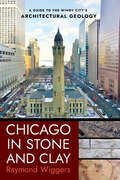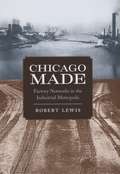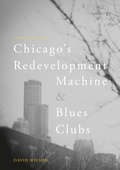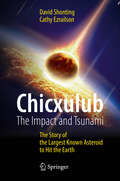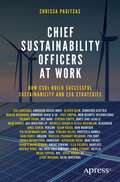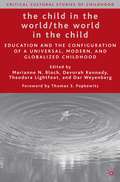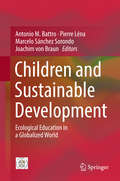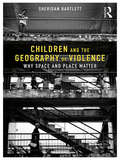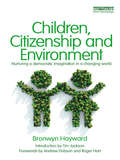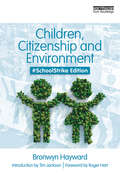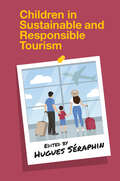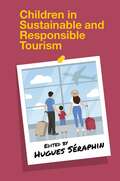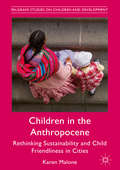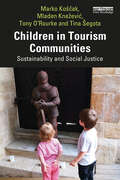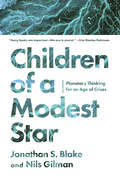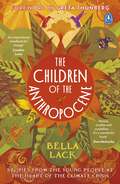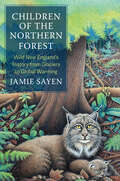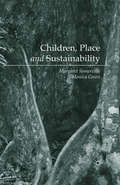- Table View
- List View
Chicago in Stone and Clay: A Guide to the Windy City's Architectural Geology
by Raymond WiggersChicago in Stone and Clay explores the interplay between the city's most architecturally significant sites, the materials they're made of, and the sediments and bedrock they are anchored in. This unique geologist's survey of Windy City neighborhoods demonstrates the fascinating and often surprising links between science, art, engineering, and urban history. Drawing on two decades of experience leading popular geology tours in Chicago, Raymond Wiggers crafted this book for readers ranging from the region's large community of amateur naturalists, "citizen scientists," and architecture buffs to geologists, architects, educators, and other professionals seeking a new perspective on the themes of architecture and urbanism. Unlike most geology and architecture books, Chicago in Stone and Clay is written in the informal, accessible style of a natural history tour guide, humanizing the science for the nonspecialist reader. Providing an exciting new angle on both architecture and natural history, Wiggers uses an integrative approach that incorporates multiple themes and perspectives to demonstrate how the urban environment presents us with a rich geologic and architectural legacy.
Chicago Made: Factory Networks in the Industrial Metropolis (Historical Studies of Urban America)
by Robert LewisFrom the lumberyards and meatpacking factories of the Southwest Side to the industrial suburbs that arose near Lake Calumet at the turn of the twentieth century, manufacturing districts shaped Chicago’s character and laid the groundwork for its transformation into a sprawling metropolis. Approaching Chicago’s story as a reflection of America’s industrial history between the Civil War and World War II, Chicago Made explores not only the well-documented workings of centrally located city factories but also the overlooked suburbanization of manufacturing and its profound effect on the metropolitan landscape. Robert Lewis documents how manufacturers, attracted to greenfield sites on the city’s outskirts, began to build factory districts there with the help of an intricate network of railroad owners, real estate developers, financiers, and wholesalers. These immense networks of social ties, organizational memberships, and financial relationships were ultimately more consequential, Lewis demonstrates, than any individual achievement. Beyond simply giving Chicago businesses competitive advantages, they transformed the economic geography of the region. Tracing these transformations across seventy-five years, Chicago Made establishes a broad new foundation for our understanding of urban industrial America.
Chicago Made: Factory Networks in the Industrial Metropolis (Historical Studies of Urban America)
by Robert LewisFrom the lumberyards and meatpacking factories of the Southwest Side to the industrial suburbs that arose near Lake Calumet at the turn of the twentieth century, manufacturing districts shaped Chicago’s character and laid the groundwork for its transformation into a sprawling metropolis. Approaching Chicago’s story as a reflection of America’s industrial history between the Civil War and World War II, Chicago Made explores not only the well-documented workings of centrally located city factories but also the overlooked suburbanization of manufacturing and its profound effect on the metropolitan landscape. Robert Lewis documents how manufacturers, attracted to greenfield sites on the city’s outskirts, began to build factory districts there with the help of an intricate network of railroad owners, real estate developers, financiers, and wholesalers. These immense networks of social ties, organizational memberships, and financial relationships were ultimately more consequential, Lewis demonstrates, than any individual achievement. Beyond simply giving Chicago businesses competitive advantages, they transformed the economic geography of the region. Tracing these transformations across seventy-five years, Chicago Made establishes a broad new foundation for our understanding of urban industrial America.
Chicago’s Redevelopment Machine and Blues Clubs
by David WilsonThis book examines the conflict surrounding the latest redevelopment frontier in Chicago: the city’s South Side blues clubs and blocks. Like Chicago, cities such as Cleveland, St. Louis, Boston, Washington D.C., Indianapolis, Milwaukee, and Philadelphia are experiencing a new redevelopment machine: one of tyrannizing and fear. Its actors are adroit at working via the creation of fear to “terror-redevelop” in these historically neglected neighborhoods. The book also discusses the powerful race and class-based politics in Chicago’s blues clubs that resist such change. A “leisure as resistance” framework represents the latest innovative form of opposition to the transformation of these historic sites.
Chicago’s Redevelopment Machine and Blues Clubs
by David WilsonThis book examines the conflict surrounding the latest redevelopment frontier in Chicago: the city’s South Side blues clubs and blocks. Like Chicago, cities such as Cleveland, St. Louis, Boston, Washington D.C., Indianapolis, Milwaukee, and Philadelphia are experiencing a new redevelopment machine: one of tyrannizing and fear. Its actors are adroit at working via the creation of fear to “terror-redevelop” in these historically neglected neighborhoods. The book also discusses the powerful race and class-based politics in Chicago’s blues clubs that resist such change. A “leisure as resistance” framework represents the latest innovative form of opposition to the transformation of these historic sites.
Chicxulub: The Story of the Largest Known Asteroid to Hit the Earth (Springer Praxis Books)
by David Shonting Cathy EzrailsonThis book tells the story of the catastrophic impact of the giant 10 Km asteroid Chicxulub into the ancient Gulf of Mexico 65.5 million years ago. The book begins with a discussion of the nature of asteroids and the likelihood of future Earth-impacts. The story then turns to the discovery of a global sediment layer attributed to the fallout from the impact and a piecing together of the evidence that revealed a monster crater, buried under the Gulf. Reviewed is the myriad of geological and fossil evidence that suggested the disastrous sequence of events occurring when a "nuclear-like" explosion ripped through the sea, Earth, and atmosphere, thus forming the mega-crater and tsunami. The aftermath of the Chicxulub's event initiated decades and more of major global climate changes including a "Nuclear Winter" of freezing darkness and blistering greenhouse warming. A chapter is dedicated to the science of tsunamis and their model generation, including a portrayal of the globally rampaging Chicxulub waves. The asteroid's global devastation killed off some 70% of animal and plant life including the dinosaurs. The study of an ancient Cambrian fossil bed suggests how "roll of the dice" events can affect the future evolution of life on Earth. We see how Chicxulub's apparent destruction of the dinosaurs, followed by the their replacement with small mammals, altered forever the progress of human evolution. This book presents a fascinating glimpse through the lens of the natural sciences - the geology, climatology, and oceanography, of the effects of an enormous astronomical event.
Chief Sustainability Officers At Work: How CSOs Build Successful Sustainability and ESG Strategies
by Chrissa PagitsasRead over 20 exclusive, in-depth interviews with chief sustainability officers (CSOs) of Fortune 500 companies such as Amazon, Coca-Cola, and Procter & Gamble and globally recognized brands such as IKEA and Netflix. These CSOs reveal how they deliver positive environmental and social impact through their companies’ core products and services and generate revenue growth while tackling unique leadership, change management, regulatory and stakeholder challenges. Sustainability and environmental, social, governance (ESG) strategies are increasingly central to businesses’ growth strategy and risk management. As a result, the CSO has become more important as a driver of both revenue and strategy. Yet, no two CSOs are alike in their backgrounds, titles or even the scope of their roles. From former Peace Corps volunteers to supply chain experts, these C-suite leaders launch ambitious carbon emissions and net-zero goals, develop new products for a circular economy, target increasing the diversity of their company’s staff, align strategic projects to the UN Sustainable Development Goals and standardize reporting for the SEC, investors and more. What You Will Learn How global multibillion dollar businesses in the United States, Europe and Asia structure their sustainability strategyHow top sustainability executives drive both business value and positive environmental and social impact How CSOs landed in their roles without climbing a traditional career ladder Who This Book Is ForExecutives and board members generally or those establishing a sustainability or ESG strategy; current and aspiring CSOs and ESG leaders; business leaders partnering with sustainability leaders and teams; and students studying the integration of sustainability and business.Advance praise for Chief Sustainability Officers At Work:"Chief sustainability officers play a critical role in supporting the broader business transition to a more just and sustainable global economy. Through dialogue with influential sustainability professionals, Chrissa brings to life the essential role in bridging gaps and helping to eliminate the divide between "traditional" business functions, senior leadership, and the sustainability teams to drive transformational change within their firms." - Mindy Lubber, CEO and President, Ceres "Chief Sustainability Officers at Work, is a fresh new book by seasoned business leader Chrissa Pagitsas that offers succinct ways anyone can implement and achieve ESG goals – whether they own the company or simply aspire to improve its impact on people and the planet. Chrissa roots this book in her own experience leading change within major companies that not only improved the businesses where she worked but improved the markets within which they needed to thrive. This is a must read for a seasoned ESG practitioner as much as it is for the young professional just getting started. Chrissa knows it is imperative we all just get started doing better and she opens up the otherwise dark box of how-tos for all of us to do our part." – Dana Bourland, SVP, The JPB Foundation and author of Gray to Green Communities: A Call to Action on the Housing and Climate Crises.
The Child in the World/The World in the Child: Education and the Configuration of a Universal, Modern, and Globalized Childhood (Critical Cultural Studies of Childhood)
by M. Bloch D. Kennedy T. Lightfoot D. WeyenbergThe contributors look at universalizing discourses concerning young children across the globe, which purport to describe everyone in a scientific and neutral way, but actually create mechanisms through which children are divided and excluded. The contributors to this book employ post-structuralist, postcolonial, and feminist theoretical frameworks.
Children and Sustainable Development: Ecological Education in a Globalized World
by Antonio M. Battro Pierre Léna Marcelo Sánchez Sorondo Joachim Von BraunThis book addresses the changes in education practices, especially basic education, necessitated by the global challenges of climate change and sustainable development and in a context characterized by increasing poverty and inequality, migration and refugees. Written by a range of international scholars, scientists and grassroots practitioners from Africa, Latin America, Asia (India, China, Malaysia) and Europe, the individual contributions focus on education policies and child development in various social contexts. Case-based experiences from both developed and developing countries provide inspiration and shed new light on the fundamental changes needed to adapt existing school systems and teacher training to face the challenges of the future. In this regard, the need to empower children themselves is emphasized.All contributions are based on a Workshop hosted in November 2015 by the Pontifical Academy of Sciences at the Vatican entitled “Children and Sustainable Development: A Challenge for Education” and follow three other significant events on sustainable development in 2015, namely the publication of Laudato Si’, the Encyclical Letter from Pope Francis, the release of the United Nations Sustainable Development Goals, and the COP21 Conference in Paris.
Children and the Geography of Violence: Why Space and Place Matter
by Sheridan BartlettViolence sabotages development, both children’s development and the development of the communities and neighbourhoods they rely on. There is abundant evidence of the deep and lasting harm that can be done. Violence breaks bodies and minds and exerts an insidious influence at every level. The effects are immediate but can also linger, damaging health, trust and capability, traveling through generations. This book argues that it is impossible to understand the violence in young children’s lives or to respond to it adequately without considering how embedded it is within their physical surroundings. The relations of power that are the context for violence within households, within communities and beyond are often expressed through control over space and the material conditions of life. This book links the abstract concept of structural violence to the stark reality of personal harm, drawing on evidence from a range of disciplines and from countries throughout the global South. It explores the dynamics of cramped, insecure housing, poor water and sanitation, neglected neighbourhoods, forced evictions, cities that segregate the rich and the poor, landscapes of conflict and disaster, and discusses their implications for young children. An alternative approach to child protection is proposed, anchored in the actions of organized communities negotiating to challenge inequities, mend their environments and achieve security. There is a fundamental synergy between building community and protecting children. These are not separate agendas. A place that works for children works better for everyone else as well. This book will be essential reading for all those interested in young children in a global context, whether as child protection professionals, or those with a more general interest in children’s rights issues or in cross cultural approaches to child development. It will also be of great interest to students and researchers of development studies, conflict studies, family studies, child development, public health and urban planning.
Children and the Geography of Violence: Why Space and Place Matter
by Sheridan BartlettViolence sabotages development, both children’s development and the development of the communities and neighbourhoods they rely on. There is abundant evidence of the deep and lasting harm that can be done. Violence breaks bodies and minds and exerts an insidious influence at every level. The effects are immediate but can also linger, damaging health, trust and capability, traveling through generations. This book argues that it is impossible to understand the violence in young children’s lives or to respond to it adequately without considering how embedded it is within their physical surroundings. The relations of power that are the context for violence within households, within communities and beyond are often expressed through control over space and the material conditions of life. This book links the abstract concept of structural violence to the stark reality of personal harm, drawing on evidence from a range of disciplines and from countries throughout the global South. It explores the dynamics of cramped, insecure housing, poor water and sanitation, neglected neighbourhoods, forced evictions, cities that segregate the rich and the poor, landscapes of conflict and disaster, and discusses their implications for young children. An alternative approach to child protection is proposed, anchored in the actions of organized communities negotiating to challenge inequities, mend their environments and achieve security. There is a fundamental synergy between building community and protecting children. These are not separate agendas. A place that works for children works better for everyone else as well. This book will be essential reading for all those interested in young children in a global context, whether as child protection professionals, or those with a more general interest in children’s rights issues or in cross cultural approaches to child development. It will also be of great interest to students and researchers of development studies, conflict studies, family studies, child development, public health and urban planning.
Children, Citizenship and Environment: Nurturing a Democratic Imagination in a Changing World
by Bronwyn HaywardChildren growing up today are confronted by four difficult and intersecting challenges: dangerous environmental change, weakening democracies, growing social inequality, and a global economy marked by unprecedented youth unemployment and unsustainable resource extraction. Yet on streets everywhere, there is also a strong, youthful energy for change. This book sets out an inspiring new agenda for citizenship and environmental education which reflects the responsibility and opportunities facing educators, researchers, parents and community groups to support young citizens as they learn to 'make a difference' on the issues that concern them. Controversial yet ultimately hopeful, political scientist Bronwyn Hayward rethinks assumptions about youth citizenship in neoliberal democracies. Her comparative discussion draws on lessons from New Zealand, a country where young citizens often express a strong sense of personal responsibility for their planet but where many children also face shocking social conditions. Hayward develops a 'SEEDS' model of ecological citizenship education (Social agency, Environmental Education, Embedded justice, Decentred deliberative democracy and Self transcendence). The discussion considers how the SEEDs model can support young citizens' democratic imagination and develop their 'handprint' for social justice. From eco-worriers and citizen-scientists to streetwise sceptics, Children, Citizenship and Environment identifies a variety of forms of citizenship and discusses why many approaches make it more difficult, not easier, for young citizens to effect change. This book will be of interest to a wide audience, in particular teachers of children aged eight to twelve and professionals who work in Environmental Citizenship Education as well as students and researchers with an interest in environmental change, democracy and intergenerational justice. Introduced by Tim Jackson, author of Prosperity without Growth, the book includes forewords by leading European and USA academics, Andrew Dobson and Roger Hart. Half the author's royalties will be donated to child poverty projects following the earthquakes in Christchurch, New Zealand. Follow Bronwyn Hayward's blog at: http://growing-greens.blogspot.co.nz/See Bronwyn Hayward discuss the book at: http://www.youtube.com/watch?v=kptEw1aZXtM&feature=youtu.be
Children, Citizenship and Environment: Nurturing a Democratic Imagination in a Changing World
by Bronwyn HaywardChildren growing up today are confronted by four difficult and intersecting challenges: dangerous environmental change, weakening democracies, growing social inequality, and a global economy marked by unprecedented youth unemployment and unsustainable resource extraction. Yet on streets everywhere, there is also a strong, youthful energy for change. This book sets out an inspiring new agenda for citizenship and environmental education which reflects the responsibility and opportunities facing educators, researchers, parents and community groups to support young citizens as they learn to 'make a difference' on the issues that concern them. Controversial yet ultimately hopeful, political scientist Bronwyn Hayward rethinks assumptions about youth citizenship in neoliberal democracies. Her comparative discussion draws on lessons from New Zealand, a country where young citizens often express a strong sense of personal responsibility for their planet but where many children also face shocking social conditions. Hayward develops a 'SEEDS' model of ecological citizenship education (Social agency, Environmental Education, Embedded justice, Decentred deliberative democracy and Self transcendence). The discussion considers how the SEEDs model can support young citizens' democratic imagination and develop their 'handprint' for social justice. From eco-worriers and citizen-scientists to streetwise sceptics, Children, Citizenship and Environment identifies a variety of forms of citizenship and discusses why many approaches make it more difficult, not easier, for young citizens to effect change. This book will be of interest to a wide audience, in particular teachers of children aged eight to twelve and professionals who work in Environmental Citizenship Education as well as students and researchers with an interest in environmental change, democracy and intergenerational justice. Introduced by Tim Jackson, author of Prosperity without Growth, the book includes forewords by leading European and USA academics, Andrew Dobson and Roger Hart. Half the author's royalties will be donated to child poverty projects following the earthquakes in Christchurch, New Zealand. Follow Bronwyn Hayward's blog at: http://growing-greens.blogspot.co.nz/See Bronwyn Hayward discuss the book at: http://www.youtube.com/watch?v=kptEw1aZXtM&feature=youtu.be
Children, Citizenship and Environment: #SchoolStrike Edition
by Bronwyn HaywardWhen it was first published in 2012, Children, Citizenship and Environment correctly predicted a strong surge in youth activism as children are confronted by four difficult and intersecting challenges: dangerous environmental change, weakening democracies, growing social inequality, and a global economy marked by unprecedented youth unemployment and unsustainable resource extraction. Nearly a decade on, global school strikes in response to the threats of chaotic climate change have underscored why youth action is vital and effective. While the experience of a world pandemic may have interrupted the rise of youthful street activism, it has also served to underscore the problems of deepening inequality and the risks of increasingly authoritarian government responses that young citizens must also confront. Against this background the message of this substantially revised edition is as important today as it was when it was first published. Controversial, yet ultimately hopeful, political scientist Bronwyn Hayward rethinks assumptions about youth citizenship in neoliberal democracies. Writing with co-authors, school climate strikers, Indigenous and disability activists, teachers, researchers and community advocates, Hayward develops her ‘SEEDS’ model of ecological citizenship for a school strike generation. The SEEDS of citizenship focus on Social agency, Environmental education, Embedded justice, Decentred deliberation and Self-transcendence. Discussion considers how these SEEDS of citizenship support young citizens’ democratic imagination and develop their ‘handprint’ for social justice. This ground-breaking book will be of interest to a wide audience, in particular teachers and professionals who work in Environmental Citizenship Education, as well as students and community activists with an interest in environmental change, democracy and intergenerational justice.
Children, Citizenship and Environment: #SchoolStrike Edition
by Bronwyn HaywardWhen it was first published in 2012, Children, Citizenship and Environment correctly predicted a strong surge in youth activism as children are confronted by four difficult and intersecting challenges: dangerous environmental change, weakening democracies, growing social inequality, and a global economy marked by unprecedented youth unemployment and unsustainable resource extraction. Nearly a decade on, global school strikes in response to the threats of chaotic climate change have underscored why youth action is vital and effective. While the experience of a world pandemic may have interrupted the rise of youthful street activism, it has also served to underscore the problems of deepening inequality and the risks of increasingly authoritarian government responses that young citizens must also confront. Against this background the message of this substantially revised edition is as important today as it was when it was first published. Controversial, yet ultimately hopeful, political scientist Bronwyn Hayward rethinks assumptions about youth citizenship in neoliberal democracies. Writing with co-authors, school climate strikers, Indigenous and disability activists, teachers, researchers and community advocates, Hayward develops her ‘SEEDS’ model of ecological citizenship for a school strike generation. The SEEDS of citizenship focus on Social agency, Environmental education, Embedded justice, Decentred deliberation and Self-transcendence. Discussion considers how these SEEDS of citizenship support young citizens’ democratic imagination and develop their ‘handprint’ for social justice. This ground-breaking book will be of interest to a wide audience, in particular teachers and professionals who work in Environmental Citizenship Education, as well as students and community activists with an interest in environmental change, democracy and intergenerational justice.
Children in Sustainable and Responsible Tourism
by Hugues SeraphinSustainability has become a core concept in considering tourism planning and development. Existing literature on sustainable tourism suggests that tourism will become more sustainable if all stakeholders participate in the tourism development process. Children in Sustainable and Responsible Tourism seeks to fill an absence of research in the sustainable and responsible tourism field involving children as stakeholders. Children in Sustainable and Responsible Tourism argues that children’s empowerment should be a core component of any responsible tourism initiatives, and that children’s involvement and support should be a requirement in helping to achieve the Sustainable Development Goals (SDGs). Hugues Séraphin’s ground-breaking study directly addresses the issue that academic researchers and industry practitioners alike have overlooked and under evaluated the significance of this key segment for the industry. Chapters address issues related to both the ‘why’ and ‘how’ of empowering children to be responsible tourists and potential future industry practitioners while providing recommendations for current industry professionals.
Children in Sustainable and Responsible Tourism
by Hugues SéraphinSustainability has become a core concept in considering tourism planning and development. Existing literature on sustainable tourism suggests that tourism will become more sustainable if all stakeholders participate in the tourism development process. Children in Sustainable and Responsible Tourism seeks to fill an absence of research in the sustainable and responsible tourism field involving children as stakeholders. Children in Sustainable and Responsible Tourism argues that children’s empowerment should be a core component of any responsible tourism initiatives, and that children’s involvement and support should be a requirement in helping to achieve the Sustainable Development Goals (SDGs). Hugues Séraphin’s ground-breaking study directly addresses the issue that academic researchers and industry practitioners alike have overlooked and under evaluated the significance of this key segment for the industry. Chapters address issues related to both the ‘why’ and ‘how’ of empowering children to be responsible tourists and potential future industry practitioners while providing recommendations for current industry professionals.
Children in the Anthropocene: Rethinking Sustainability and Child Friendliness in Cities (Palgrave Studies on Children and Development)
by Karen MaloneThis book elaborates the need, in a rapidly urbanizing world, for recognition of the ecological communities we inhabit in cities and for the development of an ethics for all entities (human and non-human) in this context. Children and their entangled relations with the human and more-than-human world are located centrally to the research on cities in Bolivia and Kazakhstan, which investigates the future challenges of the Anthropocene. The author explores these relations by employing techniques of intra-action, diffraction and onto-ethnography in order to reveal the complexities of children’s lives. These tools are supported by a theoretical framing that draws on posthumanist and new materialist literature. Through rich and complex stories of space-time-mattering in cities, this work connects children’s voices with a host of others to address the question of what it means to be a child in the Anthropocene.
Children in Tourism Communities: Sustainability and Social Justice
by Marko Koščak Mladen Knežević Tony O’Rourke Tina ŠegotaThis book explores how children living in tourism destinations are particularly susceptible to the impacts of tourism and how they can be included in public policies, programmes and decision-making, focusing particularly on case studies in Europe.Children in Tourism Communities argues that for tourism to exercise its regenerative role and encourage sustainable development, it must be inclusive of all voices, especially children who represent the future generation and will soon become adults with the rights and responsibilities for engaging in and delivering tourism activities. The book is based on original, ground-breaking research assessing the views of children regarding tourism, with a specific focus on sustainable tourism and development. It includes discussion on key case study locations including Croatia, India, Ireland, Malta, Serbia and Slovenia, although the themes, issues and practices have relevance in all tourism destinations worldwide. Through child-centred research, the book evaluates the differences between those living in mass tourism destinations and smaller-scale micro tourism areas. It encourages a rethinking of sustainability as a concept and demonstrates how tourism can be utilised as a tool for achieving the Sustainable Development Goals.This will be an important discussion text for students, academics, and instructors in sustainable tourism and development, destination management, culture and heritage, as well as practitioners engaged in continuing professional development in these areas.
Children in Tourism Communities: Sustainability and Social Justice
by Marko Koščak Mladen Knežević Tony O’Rourke Tina ŠegotaThis book explores how children living in tourism destinations are particularly susceptible to the impacts of tourism and how they can be included in public policies, programmes and decision-making, focusing particularly on case studies in Europe.Children in Tourism Communities argues that for tourism to exercise its regenerative role and encourage sustainable development, it must be inclusive of all voices, especially children who represent the future generation and will soon become adults with the rights and responsibilities for engaging in and delivering tourism activities. The book is based on original, ground-breaking research assessing the views of children regarding tourism, with a specific focus on sustainable tourism and development. It includes discussion on key case study locations including Croatia, India, Ireland, Malta, Serbia and Slovenia, although the themes, issues and practices have relevance in all tourism destinations worldwide. Through child-centred research, the book evaluates the differences between those living in mass tourism destinations and smaller-scale micro tourism areas. It encourages a rethinking of sustainability as a concept and demonstrates how tourism can be utilised as a tool for achieving the Sustainable Development Goals.This will be an important discussion text for students, academics, and instructors in sustainable tourism and development, destination management, culture and heritage, as well as practitioners engaged in continuing professional development in these areas.
Children of a Modest Star: Planetary Thinking for an Age of Crises
by Jonathan S. Blake Nils GilmanA clear-eyed and urgent vision for a new system of political governance to manage planetary issues and their local consequences. Deadly viruses, climate-changing carbon molecules, and harmful pollutants cross the globe unimpeded by national borders. While the consequences of these flows range across scales, from the planetary to the local, the authority and resources to manage them are concentrated mainly at one level: the nation-state. This profound mismatch between the scale of planetary challenges and the institutions tasked with governing them is leading to cascading systemic failures. In the groundbreaking Children of a Modest Star, Jonathan S. Blake and Nils Gilman not only challenge dominant ways of thinking about humanity's relationship to the planet and the political forms that presently govern it, but also present a new, innovative framework that corresponds to our inherently planetary condition. Drawing on intellectual history, political philosophy, and the holistic findings of Earth system science, Blake and Gilman argue that it is essential to reimagine our governing institutions in light of the fact that we can only thrive if the multi-species ecosystems we inhabit are also flourishing. Aware of the interlocking challenges we face, it is no longer adequate merely to critique our existing systems or the modernist assumptions that helped create them. Blake and Gilman propose a bold, original architecture for global governance—what they call planetary subsidiarity—designed to enable the enduring habitability of the Earth for humans and non-humans alike. Children of a Modest Star offers a clear-eyed and urgent vision for constructing a system capable of stabilizing a planet in crisis.
Children of a Modest Star: Planetary Thinking for an Age of Crises
by Jonathan S. Blake Nils GilmanA clear-eyed and urgent vision for a new system of political governance to manage planetary issues and their local consequences. Deadly viruses, climate-changing carbon molecules, and harmful pollutants cross the globe unimpeded by national borders. While the consequences of these flows range across scales, from the planetary to the local, the authority and resources to manage them are concentrated mainly at one level: the nation-state. This profound mismatch between the scale of planetary challenges and the institutions tasked with governing them is leading to cascading systemic failures. In the groundbreaking Children of a Modest Star, Jonathan S. Blake and Nils Gilman not only challenge dominant ways of thinking about humanity's relationship to the planet and the political forms that presently govern it, but also present a new, innovative framework that corresponds to our inherently planetary condition. Drawing on intellectual history, political philosophy, and the holistic findings of Earth system science, Blake and Gilman argue that it is essential to reimagine our governing institutions in light of the fact that we can only thrive if the multi-species ecosystems we inhabit are also flourishing. Aware of the interlocking challenges we face, it is no longer adequate merely to critique our existing systems or the modernist assumptions that helped create them. Blake and Gilman propose a bold, original architecture for global governance—what they call planetary subsidiarity—designed to enable the enduring habitability of the Earth for humans and non-humans alike. Children of a Modest Star offers a clear-eyed and urgent vision for constructing a system capable of stabilizing a planet in crisis.
The Children of the Anthropocene: Stories from the Young People at the Heart of the Climate Crisis
by Bella Lack'An inspirational manifesto for change' Caroline Lucas, former leader of The Green Party 'A remarkable and important book' Steve Backshall, Naturalist, Broadcaster, and Author'Astute, erudite and crystalline, Bella writes with visionary clarity and passion [...] It's a wonderful book' Dara McAnulty, award-winning author of Diary of a Young Naturalist____________________________Across the planet, the futures of young people hang in the balance as they face the harsh realities of the environmental crisis. Isn't it time we made their voices heard?The Children of the Anthropocene, by conservationist and activist Bella Lack, chronicles the lives of the diverse young people on the frontlines of the environmental crisis around the world, amplifying the voices of those living at the heart of the crisis.Advocating for the protection of both people and the planet, Bella restores the beating heart to global environmental issues, from air pollution to deforestation and overconsumption, by telling the stories of those most directly affected. Transporting us from the humming bounty of Ecuador's Choco Rainforest and the graceful arcs of the Himalayan Mountains, to the windswept plains and vibrant vistas of life in Altiplano, Bella speaks to young activists from around the world including Dara McAnulty, Afroz Shah and Artemisa Xakriabá, and brings the crisis vividly to life.It's time we passed the mic and listened to different perspectives. Bella's manifestos for change will inspire and mobilize you to rediscover the wonders and wilds of nature and, ultimately, change the way you think about our planet in crisis. This is your chance to hear the urgent stories of an endangered species too often overlooked: the children of the Anthropocene. ____________________________'Extraordinarily moving, wild and engaging - the book of the moment' Mary Robinson, Former President of Ireland and author of Climate Justice'A visionary statement for the future [...] Pragmatic, positive & beautifully written' Ben Macdonald, Award-Winning Conservation Writer, Wildlife TV Producer and Naturalist
Children of the Northern Forest: Wild New England's History from Glaciers to Global Warming (Yale Agrarian Studies Series)
by Jamie SayenThis no-holds-barred narrative of the failure of conservation in northern New England’s forests envisions a wilder, more equitable, lower-carbon future for forest-dependent communities Jamie Sayen approaches the story of northern New England’s undeveloped forests from the viewpoints of the previously unheard: the forest and the nonhuman species it sustains, the First Peoples, and, in more recent times, the disenfranchised human voices of the forest, including those of loggers, mill workers, and citizens who, like Henry David Thoreau, wish to speak a kind word for nature. From 1988 to 2016 paper companies sold their timberlands and closed seventeen paper mills in northern New England. Policy makers ceded veto power to large absentee landowners, who tried to preserve the status quo by demanding additional tax cuts and other subsidies for economic elites. They vetoed measures designed to restore and preserve forest health; at present, about half of the former industrial forests are classified as degraded, and the regional economy continues to be trapped in low-value commodity markets. This book operates as a case study of how a rural resource region can respond to a global economy responsible for climate change, habitat loss and degradation, and environmental injustice. Sayen offers a blueprint for restoring vast wildlands and transitioning to a lower-carbon, high-value-adding, local economy, while protecting the natural rights of humans, nonhumans, and unborn generations.
Children, Place and Sustainability
by Margaret Somerville Monica GreenThrough focusing on children's sustainability learning this book examines how school education can address the current environmental problems. It explores children's responses in literacy and language, arts-based approaches, and indigenous studies as well as scientific pedagogies to provide a unique insight into how children learn.
